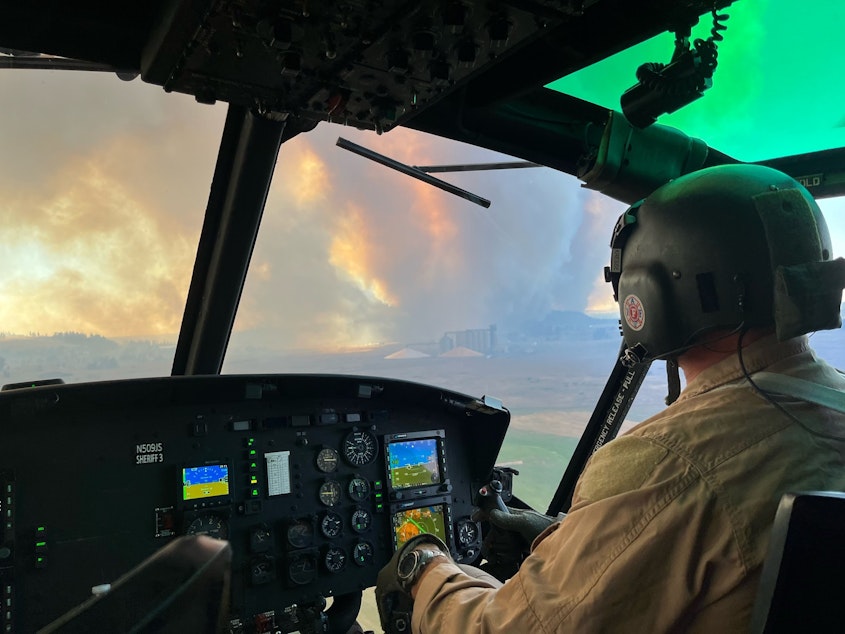Fuel, heat, drought, wind: Recipe for big Spokane wildfires

Fires broke out in at least four locations around Spokane County and neighboring counties last Friday. Strong winds soon fanned the trees, brush and grasses into life-threatening conflagrations.
One person died Saturday in the Gray Fire southwest of Spokane; another died in the Oregon Road Fire north of Spokane on Sunday.
“There has been a lot of fire in the county these last few days, impacting everyone in the community directly or indirectly and leaving many firefighters exhausted,” the Spokane Fire Department posted on social media on Sunday.
RELATED: Emergency declaration as Spokane battles deadly wildfires
Though the fires’ immediate causes are under investigation, no lightning storm sparked these near-simultaneous ignitions, according to Washington Department of Natural Resources spokesperson Thomas Kyle-Milward.
“We were seeing and projecting really dry, hot conditions out on the landscape, leaving fuels really ripe for any sort of ignition,” he said.
Since May, Spokane International Airport has received less than half its normal rainfall (1.1 inches versus 2.5 inches), according to Washington state Climatologist Nick Bond. In July, the airport was 3.8 degrees hotter than its 30-year average. So far in August, it has been 5.3 degrees hotter than normal.
Sponsored
Spokane County has been in a “moderate drought” since mid-July, according to the University of Nebraska-Lincoln’s U.S Drought Monitor, though the county was not included in Washington state’s emergency drought declaration for parts of 12 counties on July 24.
With the Spokane airport reporting winds gusting up to 37 miles an hour Friday afternoon, flames quickly hopped across the landscape.
“It's incredibly hard to blunt that forward progress of the fire when it's got a strong wind behind it, regardless of how many assets you may or may not have,” Kyle-Milward said.
“If the fuels are there, it's a simple equation: the hotter and drier it is, the more intense the wildfire,” said University of Washington-Tacoma wildfire ecologist Maureen Kennedy.
RELATED: Hundreds of animals evacuated from massive fires burning near Spokane
Fire season in the Northwest often peaks around Labor Day and lasts until rains and mountain snows snuff it out, typically in October.
Sponsored
To date in 2023, nearly 150,000 acres have burned in Washington, a pace that would yield a relatively mild fire year in terms of acreage, according to Kyle-Milward. Over the past decade, Washington has averaged about 460,000 acres burning annually, with extreme years like 2015 and 2020 seeing roughly twice that amount go up in flames.
Hotter, drier summers fueled by global climate change have lengthened fire seasons and left places like Spokane County more prone to burning. But climate is just one of the factors setting the stage for the Spokane area’s most recent fires.
Decades of aggressive fire suppression in the western United States dramatically reduced the burned acreage compared to the early 20th century and earlier. It also left forests thick with brush and smaller trees, making the land more prone to extreme burning when fires do ignite.
Western fires have been increasing in size and severity for the past half-century. Still, researchers say they burn only about one-tenth of the area they did before Europeans settled the West.
“We are in a wildfire deficit still, relative to what had been maintained historically, before European colonization and settlements,” Kennedy said.
Sponsored
Fire researchers say reducing the destructiveness of western wildfires could—counterintuitively—require having more, not fewer, acres burn.
“Fire's inevitable in our productive forested systems and our shrub lands and our grasslands,” Kennedy said. “So it's not a matter of trying to create a world where there is no fire. That world is desert or concrete, and we don't want that, right?”
The goal, Kennedy said, must be to transform how and where fire burns so it causes less harm to infrastructure and communities.
Thinning out areas of dense vegetation and prescribed burning under controlled conditions can yield blazes that burn less severely — often leaving bigger trees unscathed—and reduce the chances of extreme fires burning out of control.
State officials say the Gray fire has destroyed at least 180 buildings and the Oregon Road fire about 80 buildings.
Sponsored
Those tallies make them the state’s most destructive fires since September 2020, when the Babb-Malden fire leveled 223 buildings, including most of the town of Malden, 30 miles south of Spokane, and the Cold Springs Fire destroyed 78 homes and 60 secondary buildings on the Colville Reservation.




